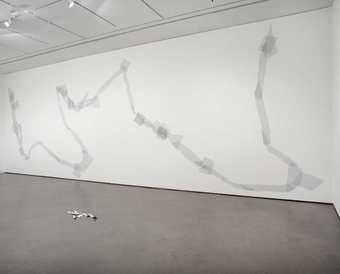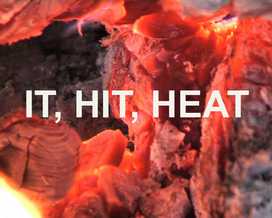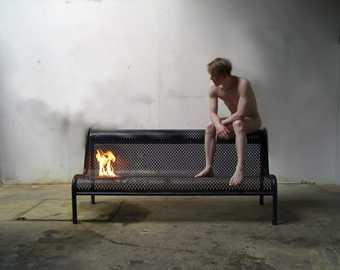David Musgrave creates understated yet poignant works which demand a level of scrutiny and contemplation rarely encouraged in most forms of contemporary culture. The speculative potential of visual experience lies at the very heart of Musgrave’s practice, and the rewards for the viewer lie in an intellectual engagement with the games of illusion played by the artist, as well as an enjoyable aesthetic encounter. Yet the means are simple; most of the materials Musgrave uses might be supplied at primary school – paper, plasticine, graphite pencil and paint.
In works created especially for this Art Now exhibition, Musgrave uses diverse means to further his investigations into art’s capacity for representation. We all share a drive to recognise the human in what we see, and he pushes this desire to its limits. His anthropomorphic forms are invariably created from an unseen original, then enlarged and translated into different media. Thus the floor sculpture, Paper golem, began as torn pieces of paper shuffled around until the arrangement offered just the slightest echo of a recognisable figure. This moment is frozen by translating the pieces of paper into painted aluminium, so that what might be taken at first glance to be a casual presentation is in fact a precise and meticulously made recreation. In this playful way the viewer’s attention is shifted from recognising the subject to deciphering the process through which it has been created. It is at this moment that the actual subject of the work begins to emerge; its content lies not in how lifelike – or abstract – a figure is, but in the very process of working through the layers of suggestion and allusion. The actual attempt to represent, and the viewer’s instinctive response to this, is what fascinates Musgrave. It is not necessarily what is being presented, but the cognitive process through which we recognise – or misrecognise – what is happening that offers a key to the subject of the work.
In these new works the legibility of the figure is broken down to an unprecedented level. The wall painting relates more to abstraction than figuration, the result of what Musgrave calls an attempt to ‘disintegrate the figure into a gesture’. In order to get to this point, he has repeatedly torn up and repaired a paper maquette in a process he describes as ‘unfolding the figure into abstraction’. Yet we are encouraged to see a human form by its title: Giant torn tape figure (grey). There is no tape though, but a realistic representation of it using varying shades of silk emulsion paint. Within this completely flat, two-dimensional work the illusion of space is captured within the layers painted directly onto the wall, creating the impression that the figure is constructed from overlapping pieces of a translucent material. For Musgrave, the consistent references to something outside of the work itself – the human form, the activity of making – is vital as a way to explore both issues of representation and the complexities of a formal process. Just as the huge tape figure twists its way along the wall, so the work avoids being pinned down to any one meaning.
The way in which this piece holds the vast wall and architectural space, despite the neutrality of the colours and subtlety of line, contrasts sharply with the intense, highly reflective figure presented on the adjacent wall. This tiny object was created by squeezing paint from the tube and remodelling it in epoxy putty. Coated with a high gloss cadmium red paint this work, simply called Painted form no.2, has a jewel-like quality. The drawing on the opposite wall also derives from a loosely modelled figure, this time in plasticine, which is then enlarged and drawn in graphite pencil. Since Musgrave makes these drawings freehand there is a level of interpretation and therefore error. A drawing rendered realistically is inevitably slightly altered from its original image, thus entrapping the viewer in the gap between real experience and imagination. In his line drawing, Animal Forms, Musgrave presents a cluster of imaginary forms that begin to produce a figure, but retail their own identity. While stylistically different from the drawing in graphite, it produces a similar uncertainty about how the image should be read.
In this deliberately pared down exhibition, each work exists independently and yet plays a supporting role to the other pieces displayed. The wide range of media used by Musgrave allows him to experiment, at times manipulating a substance, at others allowing it to behave according to its natural properties. In a delicate balance of scale, medium and process, each work demands attention and consideration, and in taking the time the viewer slowly unravels the exquisite tension between figuration and abstraction, identification and deception, materiality and immateriality.
Text by Katharine Stout
Biography
Musgrave (born 1973) studied at Wimbledon College of Art and Chelsea College of Art and Design, London. He is currently exhibiting at the Arnolfini, Bristol (16 May - 6 July 2003), and has recently shown at the Mark Foxx Gallery, Los Angeles with Roger Hiorns (2003) and at Transmission, Glasgow (2002). He has had solo exhibitions at greengrassi, London (2001 and 2000) and at Duncan Cargill Gallery, London (1998). He has been in numerous international group exhibitions including Casino 2001, S.M.A.K., Ghent (2001) and the British Art Show 5 (2000). He lives and works in London.






